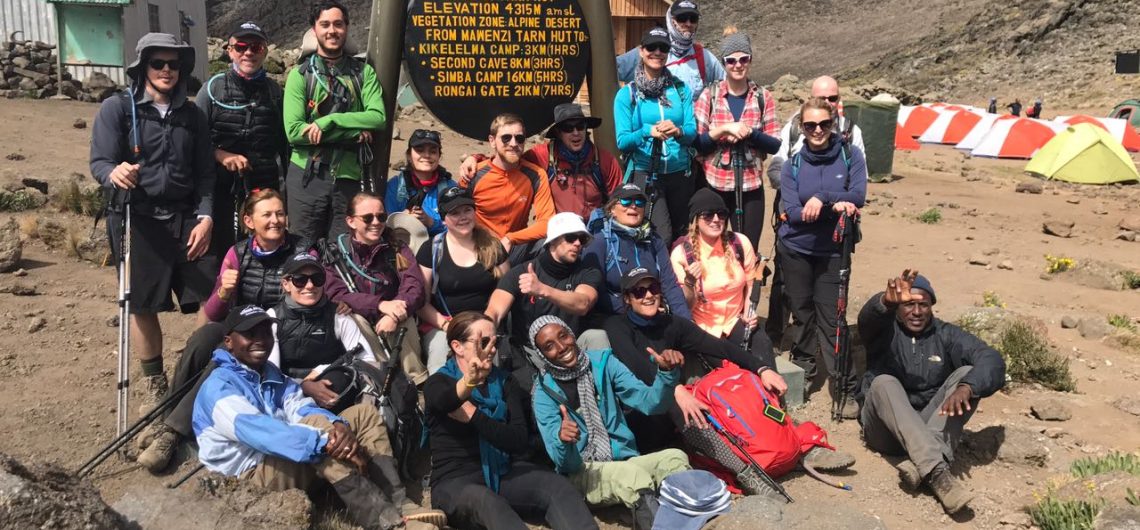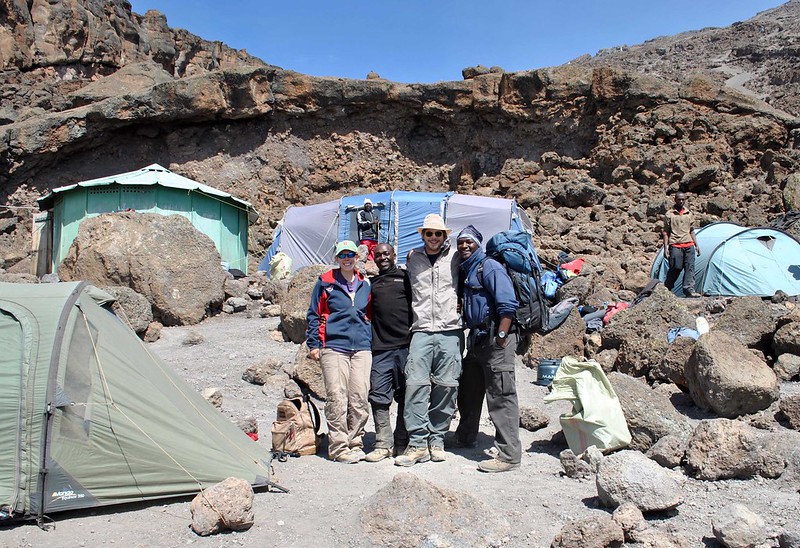So you are not sure what you should wear on each day you are on Kilimanjaro to combat the harsh conditions that come with each zone, the higher you go. Mount Kilimanjaro, Africa’s highest peak, presents climbers with a unique challenge: trekking through multiple climate zones in just a few days, from tropical rainforests to arctic conditions at the summit. Planning what to wear each day can be as daunting as the climb itself.
Choosing the right attire for climbing Mount Kilimanjaro is a frequent concern for trekkers, and while there’s a detailed gear list on our site, knowing when to wear what, can be less straightforward. The key to dressing appropriately lies in adaptability due to Kilimanjaro’s unpredictable weather.
For instance, one might experience sub-zero temperatures one night and comparably warmer conditions during the summit push the next day. This variability means your clothing strategy must be flexible.
Getting on an expedition up Mount Kilimanjaro is akin to traversing from the hot, humid tropics to the freezing, desolate conditions of the Arctic in a matter of days. This dramatic shift in climate zones presents unique challenges for climbers, particularly when it comes to what to wear. Kilimanjaro’s weather can swing from temperatures over 100 degrees Fahrenheit at its base to well below zero near its summit. Therefore, understanding how to dress effectively becomes not just a matter of comfort, but of safety and success in reaching Africa’s highest peak.
Before getting further on this topic, you might consider reading the recommended Kilimanjaro gear list to get an insight on what to wear each day on the mountain. The Ultimate Kilimanjaro Climbing Gear Recommendations Checklist
Mount Kilimanjaro, standing majestically in Tanzania, is not only a test of physical endurance but also a lesson in meteorological diversity. Climbers begin their ascent in warm, possibly humid conditions, making their way through lush rainforests, only to end at the glacier-capped summit where the air is thin and the cold bites fiercely. This journey through multiple ecosystems means that your wardrobe must be as adaptable as the mountain’s weather. Here, we’ll explore how to appropriately layer your clothing to manage these drastic changes, ensuring comfort, protection, and ultimately, a successful summit.
Understanding Kilimanjaro’s Climate Zones
Before we dive into daily attire, it’s essential to understand the mountain’s distinct climate zones:
- Cultivation Zone: Warm and humid, where you start your journey.
- Rainforest Zone: Still warm but can get quite wet.
- Moorland Zone: Cooler, with less humidity and more open terrain.
- Alpine Desert Zone: Dry, with significant temperature fluctuations between day and night.
- Arctic Zone: At the summit, expect freezing temperatures and possible snow.
Day-by-Day Clothing Guide
Dressing for Kilimanjaro isn’t about adhering to a strict daily uniform but adapting dynamically to the mountain’s whims. By understanding and utilizing the layering system, you equip yourself not just to survive but to thrive in Kilimanjaro’s challenging environment. With the right gear, carefully chosen for each phase of your ascent, you’ll be prepared to face whatever weather the mountain throws at you, from the sunny base to the frosty peak.
Day 1-2: Lower Slopes and Rainforest
- Morning: Start with moisture-wicking T-shirts or light long-sleeve shirts to manage sweat. Quick-dry shorts or convertible pants are ideal as you’ll still be in relatively warm conditions.
- Evening: As you ascend, temperatures drop. Add a fleece layer or a light jacket. Long trousers will be more comfortable here.
Day 3-4: Moorland
- Daytime: Here, the sun can be intense, but the air is cooler. Continue with your base layers, but consider UV-protective long sleeves. A hat with a brim or a cap, along with sunglasses, becomes necessary for sun protection.
- Evening: Temperatures fall further. A thicker fleece or a thermal top and bottom will be required. A beanie and gloves might also come into play.
Day 5-6: Alpine Desert
- Day: The temperature varies widely. You might start in your warmer layers due to the morning chill but strip down to lighter layers as the day warms up. Keep your rain gear accessible as weather changes can be sudden.
- Night: This is where your heavy gear starts to shine. Insulated jackets, thermal base layers, and waterproof pants will be essential, especially as you prepare for your summit push.
Summit Night/Day (Typically Day 6 or 7 depending on your route)
- Summit Attempt: Dress in layers. Start with thermal base layers, add fleece or insulated synthetic/down jackets, and top with a windproof and waterproof outer shell. Gloves should be insulated, potentially with liners. A balaclava or a neck gaiter along with a warm hat is crucial. Snow goggles or quality sunglasses for the descent are vital due to glare off the glaciers.
- Descent: You might shed layers quickly as you descend back into warmer zones, but keep your outer layers handy for sudden weather changes.
Post-Summit Days
- Return through the Zones: Reverse the process. As you descend, you’ll peel off layers. However, keep your rain gear close as the lower you go, the higher the chance of encountering rain.
Layering: Your Best Strategy Against the Elements
The key to conquering Kilimanjaro’s climate is the art of layering. Layering involves wearing multiple layers of clothing, each serving a specific function:
- Base Layer: This is the layer closest to your skin, designed primarily to wick away sweat, keeping you dry. Materials like silk, wool, or synthetic blends are ideal. Avoid cotton, as it retains moisture, which can lead to chilling or even hypothermia in cold conditions.
- Mid Layer: Here, insulation is the goal. Fleece, synthetic, or down jackets provide warmth by trapping air. Fleece is versatile for various conditions, while down offers the best warmth-to-weight ratio, though it must be kept dry. Synthetic insulations maintain some warmth when wet and are often less expensive than down.
- Outer Layer: Also known as the shell layer, this should protect you from wind, rain, and snow. Look for waterproof, breathable materials like Gore-Tex. This layer must allow sweat vapor to escape while keeping external moisture out.
Adapting Day by Day
While you can’t predict the exact weather for each day of your climb, here’s how you might adapt your layers:
- Lower Slopes: Start with moisture-wicking T-shirts or light long sleeves, and perhaps shorts or convertible pants. As you move higher, add a fleece or light jacket.
- Mid-Mountain: Here, UV protection becomes crucial, so long sleeves, hats, and sunglasses are necessary. Temperatures fluctuate, so having layers to add or remove is key.
- Higher Altitudes: As you approach the summit, your clothing must combat extreme cold. This is where your heavy down or synthetic insulated jackets, thermal base layers, and waterproof pants come into play. Gloves, a balaclava, or neck gaiter, and warm hats are indispensable.
- Summit Push: Dress in your warmest gear, ensuring you have enough layers to stay warm but can still move comfortably. Insulated gloves, multiple base layers, and your thickest jacket will be critical.
Kilimanjaro Clothing Guide
Here’s a comprehensive guide to help you dress appropriately for each stage of your Kilimanjaro adventure.
- Layering: This is your best strategy. Layers allow you to adjust your clothing for insulation, breathability, and protection against external elements like wind or rain.
- Material Matters: Choose synthetic materials or merino wool for base layers due to their moisture-wicking properties. Avoid cotton as it retains moisture and can lead to hypothermia in cold conditions.
- Accessibility: Keep your next layer or rain protection easily accessible. Conditions can change rapidly on the mountain.
- Individual Differences: Like the group in the photo at School Hut, everyone feels temperature differently. Don’t hesitate to adjust according to your comfort.
- Flexibility: Carry gear in your daypack that you can quickly add or remove. Weather on Kilimanjaro can change in an instant.
- Preparation: Don’t wait to feel cold or wet; preemptively adjust your layers.
- Personal Comfort: Remember, everyone feels temperature differently. Adjust according to your own comfort, not just what others are doing.
Choosing the dress code for Kilimanjaro
Packing for Kilimanjaro requires careful consideration of the mountain’s varied climates. While there are no strict rules for what to wear each day due to personal comfort levels and weather variability, the principle of layering and preparation for all weather conditions will serve you well. Remember, your guide’s advice on local weather conditions will be invaluable, so listen closely and adjust your gear accordingly. With the right clothing strategy, you’ll not only reach the summit but do so with comfort and perhaps even style, just like the diverse group at School Hut.
When hiking across the five temperature zones of Kilimanjaro, what should you wear? This mountain will require a lot of wardrobe adjustments due to the temperature swings between the chilly drifts at the summit (-10 degrees) and the humid, equatorial heat of the rainforest (highs of 70–90 degrees).
You also won’t simply switch clothes in each zone. Kilimanjaro produces its own weather, which frequently shifts in a matter of hours. When the temperature drops after sunset, you’ll bundle up and remove layers in the hot noon heat. You might encounter anything in between, such as a chilly wind, rain, mist, or a gentle, lovely atmosphere.
It requires planning to get ready for everything. After all, the 33-pound weight limit on luggage means you can only pack so much. Luckily, a lot of the thinking has already been done for you! We’ll go over the characteristics of each layer of your clothes below so you know what kinds of materials to look for. After that, we’ll offer some detailed advice.
![]()


